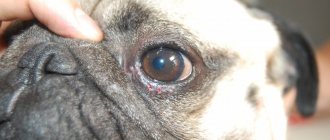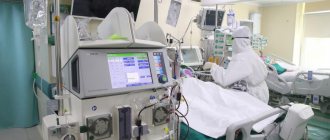Hereditary pathologies of the retina in cats
Boyarinov S.A. – veterinary ophthalmologist IVC MBA, microsurgeon
The retina is a unique organ, which is determined by the complexity of its structure and subtle functioning mechanisms. Any pathological changes occurring in the retina are reflected in the visual functions of animals, and, accordingly, on the perception of the surrounding world.
Figure 1. Fundus of healthy cats under ophthalmoscopy.
Retinal pathologies in cats occupy one of the leading places in the development of low vision and blindness.
Among these pathologies, a special place is occupied by hereditary diseases of the retina of cats, which can be transmitted from generation to generation and lead to irreversible blindness. A distinctive feature of hereditary retinal pathologies in cats is a strict breed predisposition. This means that only cat breeds such as the Abyssinian or Persian, as well as a few others, can have such serious diseases. It is worth noting that, unlike dogs, this pathology is much less common in cats and affects young animals.
Pet owners may notice the following symptoms of disease:
- Decreased vision at any time of the day;
- Dilated pupils (mydriasis);
- Involuntary oscillatory eye movements (nystagmus).
Figure 2. Assessment of chromatic pupillary responses.
The diagnosis of hereditary retinal disease in cats is made only on the basis of a comprehensive ophthalmological examination. Mandatory and key research methods are examination of the fundus (ophthalmoscopy and fundoscopy), as well as examination of retinal activity (electroretinography and assessment of chromatic pupillary reactions).
Hereditary early rod-cone dysplasia of the retina (early-onset rod–cone dysplasia (Rdy)
The disease occurs in Abyssinian cats. It develops already at a young age in kittens and affects both eyes. Rod-cone dysplasia is a hereditary disease and develops in an autosomal dominant pattern in Abyssinian cats. The common clinical symptom characterizing early rod-cone retinal dysplasia is decreased pupillary reflex, mydriasis, nystagmus and vision loss.
With fundus ophthalmoscopy, the first pathological changes can be visualized in kittens from 2-3 months of age. These changes include:
- tapetal hyperreflexia (reflectivity);
- loss of pigmentation;
- thinning and/or disappearance of retinal vessels.
With electroretinography, changes in the functional state of rods and cones are recorded already on the 14th day of life of kittens. The pathological process begins, as a rule, in the central zone of the retina and spreads to the periphery, ultimately affecting the entire retina.
There is no treatment for hereditary rod-cone retinal dysplasia, so it is necessary to carry out selection work aimed at excluding from breeding animals that carry the mutant gene.
Figure 3 . Fundus of cats with hereditary retinal pathologies.
Recessively-inherited rod–cone degeneration (rdAc)
The disease occurs in cats of the Abyssinian and Somali breeds . The initial stage of the pathology begins at 1.5-2 years of age and over the next 2-4 years progresses to complete loss of vision in both eyes.
Hereditary rod-cone retinal degeneration is characterized by development in several stages. Symptoms of the disease include: discoloration of the peripapillary zone in the precursor stage, discoloration of the tapetum and weakening of the vasculature in the early stage, the appearance of local hyperreflexia and disappearance of retinal vessels in the moderately advanced stage, and generalized hyperreflexia and complete absence of retinal vessels in the advanced stage.
With electroretinography, changes in the functional state of rods and cones are recorded already from 8-12 weeks of age in cats, which can be used for early diagnosis of the disease, when ophthalmoscopic changes are not yet observed.
There is no treatment for hereditary rod-cone retinal degeneration, so it is necessary to carry out selection work aimed at excluding sick animals from breeding.
Hereditary early progressive retinal atrophy in Persian cats (PRA)
The disease occurs in Persian and is hereditary, developing in an autosomal recessive manner.
The pathology affects both eyes and is clinically manifested at 2-3 weeks of age by a decrease in the pupillary reflex. Complete blindness occurs at 16-17 weeks of age.
Ophthalmoscopic changes are observed from 2-4 weeks of age and include weakening of the vasculature, in particular the central veins and retinal arteries. From 6 weeks of age, there is an increase in the reflectivity of the tapetum and the development of hyperreflexia. From 9 weeks of age, hyperpigmentation and atrophy of the optic nerve head are recorded.
Figure 4. Fundus of cats with hereditary retinal pathologies.
Electroretinography also notes a decrease in the activity of the rod-cone response at the early stage of the disease, which speaks of this pathology as a disease with an early onset.
There is no treatment for hereditary early retinal atrophy in Persian cats. Since this pathology is hereditary and is passed on from generation to generation, it is necessary to exclude from breeding animals that carry the defective gene.
Hereditary early progressive retinal atrophy in Bengal cats (PRA)
The disease occurs in Bengal cats and is hereditary, developing in an autosomal recessive manner with an early onset. This pathology has no connection with a similar pathology in Persian cats.
Retinal lesions develop symmetrically in both eyes in kittens from 8 weeks of age and progress to complete blindness by 6 months.
Figure 5 . Fundus of cats with hereditary retinal pathologies.
Unlike early hereditary retinal atrophies in Persian and Abyssinian cats, which are clinically manifested by a decrease in the pupillary reflex in the initial stages, visual clinical symptoms of this pathology are observed closer to 1 year of the animal’s life, which significantly complicates the ability to detect retinal atrophy in the early stages.
Pathological changes in the fundus of the eye with progressive retinal atrophy in Bengal cats can be visualized starting at 8 weeks of age and include a generalized increase in granularity, an increase in the reflectivity of the tapetum, weakening of the vasculature, and a decrease in the diameter of veins and arteries. By 20-25 weeks of age, the changes become more pronounced, and by 40-60 weeks, total retinal degeneration is observed: generalized hyperreflexia, disappearance of central and peripheral vessels.
There is no treatment for hereditary early retinal atrophy in Bengal cats. Since this pathology is hereditary, it is necessary to exclude from breeding animals that carry the defective gene.
In conclusion, it is worth noting that hereditary retinal pathologies are a serious eye disease that irreversibly leads to blindness.
Unfortunately, no treatment for these pathologies has been developed. However, when making a diagnosis, it is necessary to exclude animals from breeding to prevent the spread of pathology among cats. Return to list
Symptoms: how does pathology manifest itself?
With this pathology, going down stairs becomes a problem for the animal.
With retinal atrophy, a cat has no pain syndrome, so the owner may not know for a long time that the pet is sick. In addition, the cat has an excellent memory, which the animal uses when its vision decreases. Numerous vibrissae also help to navigate. However, in an unfamiliar environment the animal becomes helpless. Veterinarians recommend identifying that a cat has retinal atrophy based on the following signs:
- reluctance to go down stairs;
- bumping into an obstacle, especially if there was none before;
- lack of movement in the dark;
- dilated pupils;
- reflection of light rays from the back of the organ;
- cataract.
Diagnostics
Diagnosis is carried out by a specialist - an ophthalmologist.
In the case of uveitis, this includes:
- Physical examination. With this research method, a general examination of both eyes and surrounding tissues is carried out, and the reflexes of the visual apparatus are checked.
- Ophthalmological examination. It is performed using special equipment (slit lamp, direct or indirect ophthalmoscope).
- Tonometry is the measurement of intraocular pressure. Produced by Tonovet and Tonopen tonometers.
- Blood tests: biochemical and general clinical.
- Tests for infections using PCR, ELISA.
- Tests to determine systemic pathologies.
Causes of retinal detachment
This pathology of the organ of vision is a serious problem for both the patient and the ophthalmologist. And if no action is taken immediately, the disease can lead to significant vision loss or even irreversible blindness. Retinal detachment occurs at any age, but, as a rule, it occurs in patients in the middle and older age range.
Patients suffering from myopia are at risk of developing the disease; having a history of inflammatory diseases of the eye or injuries and wounds of the eyeball; who have undergone surgical treatment for cataracts.
In addition, the risk group includes patients whose family members have a history of retinal detachment, as well as patients suffering from general somatic diseases such as diabetes mellitus, systemic diseases, kidney pathology and infectious diseases.
According to the mechanism of development, retinal detachment can be of three types, depending on the cause of the disease: rhegmatogenous, traction and exudative retinal detachment.
Exudative (serous) retinal detachment
Retinal detachment in this case is caused by the accumulation of fluid in the subretinal space. The causes of retinal detachment in the exudative nature of the disease are diverse and are caused either by pathology of the retinal vessels, or by dysfunction of the underlying choroid due to inflammatory, infectious diseases, malignant neoplasms or genetically determined diseases.
The causes of retinal detachment due to pathology of the retinal vessels are: thrombosis of the central retinal vein or its branches, retinal vasculitis, Leber angiomatosis, Coats retinitis, Hippel-Lindau disease.
The following diseases can lead to dysfunction of the choroid and the development of serous retinal detachment:
- Congenital pathology – coloboma of the choroid and optic nerve, nanophthalmos, familial exudative vitreoretinopathy.
- Inflammatory diseases - orbital pseudotumor, lymphomatoid granulomatosis, scleritis, Vogt-Koyanagi-Harada syndrome, collagen vascular diseases, ulcerative colitis, Crohn's disease, sarcoidosis, Wegener's granulomatosis.
- Infectious diseases - Lyme disease, syphilis, cytomegalovirus retinitis, toxoplasmosis, tuberculosis, Dengue fever and cat scratch disease.
- Systemic diseases accompanied by impaired blood flow in the choroid - collagen vascular diseases, preeclampsia and eclampsia, disseminated intravascular coagulation syndrome, malignant hypertension.
- Kidney diseases - lupus nephritis, type II membranoproliferative glomerulonephritis with chronic renal failure, IgA nephropathy, Goodpasture syndrome, patients on hemodialysis.
- Neoplasms. Exudative retinal detachment can be caused by: choroidal nevus, choroidal melanoma or metastases to the choroid, choroidal hemangioma, primary intraocular lymphoma, retinoblastoma.
- Idiopathic causes: central serous chorioretinopathy, uveal effusion syndrome.
- Iatrogenic causes. In this case, separation of the retina from the underlying membranes may occur after ophthalmological operations - inadequate episcleral filling, excessive panretinal laser coagulation.
| Photo 4. Retinal detachment due to choroidal melanoma | Exudative retinal detachment. Photo 5 |
Regardless of the cause, retinal detachment has a characteristic clinical picture and symptoms. More information about the symptoms of the disease and methods of surgical treatment can be found on the corresponding pages of our website.
REMEMBER! If the disease is neglected, retinal detachment threatens irreversible blindness, and the patient may permanently lose the ability to see. Particular attention should be paid to those patients who have already had retinal detachment in the fellow eye. In this case, you should be dynamically observed by an ophthalmologist, usually 2 - 3 times a year. And if suspicious symptoms occur, immediately seek advice from your doctor.
How is the treatment carried out?
Veterinarians clarify that with progressive retinal atrophy, treatment of concomitant diseases with drugs containing fluoroquinolones is prohibited.
The treatment regimen is determined by the veterinarian; self-medication is prohibited. Progressive retinal atrophy in cats is incurable. To stop the development of the disease, veterinarians recommend introducing vitamin supplements with taurine into the diet - Doctor Zoo, Beafar, Gimpet. Useful foods containing this component are “Friskes”, “Night Hunter”, “Sheba”, “Kitiket”, grain-free ones – “Grandorf”, “Akana”, “Go”. Mitochondrial antioxidants are also used, which stop the progression of the disease. Monitoring the animal’s body weight and glucose levels if diabetes is diagnosed will help slow down the disease.
Traction retinal detachment
Tractional retinal detachment is the second most common type of retinal detachment. The main causes of retinal detachment due to the traction mechanism of the development of the disease are the presence of dense adhesions between the retina and the vitreous body, which form against the background of various pathological processes in the eye. The most significant example is the development of the disease in diabetes mellitus, penetrating wounds or contusions of the eye, and sickle cell anemia.
Thus, in patients with diabetes mellitus, tractional retinal detachment is the main cause of blindness and low vision due to vitreoretinal traction syndrome and occurs, according to various authors, in 36-50% of cases of proliferative diabetic retinopathy.
Vitreoretinal traction syndrome is characterized by the formation of delicate connective tissue membranes on the surface of the retina and in the vitreous body. Over time, the membranes become denser and begin to contract, which leads to tension on the retina from the altered vitreous body in the area of dense vitreoretinal adhesions, followed by detachment of the retina from the underlying pigment epithelium and choroid, even without the formation of a break in the retina.
When traction is combined with the formation of a retinal tear, retinal detachment is called traction-rhegmatogenous.
| Traction retinal detachment | Photo 3. Retinal detachment in diabetes |









